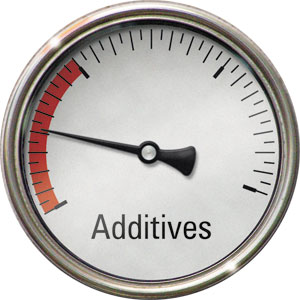The Silent Danger of Abrupt Lubricant Failure

How fast can your car go with a full tank of gas as opposed to just one gallon of gas? It would be practically the same, right? Not only would the car drive just as fast, but unless you want to consider the weight, there would be no difference in performance. Now imagine driving a car without a fuel tank gauge. After each refueling, you would have an increasing fear that your car could run out of gas at any moment. Your only solution would be to refuel at a frequency that was safely ahead of when you estimate the tank to be empty. Otherwise, you would regularly encounter moments of unexpected inoperability.
Just like a car, lubricants generally perform as expected for extended periods of time without any dramatic signs of degradation. The remaining “fuel” in this case would be reserve additives or inversely related to contamination levels. Unfortunately, you don’t have a gauge to display the remaining useful life of key additives.
An antioxidant is an example of an additive that will be expended over its useful life until it becomes empty without warning. The effects of this are exponentially unfavorable. Before antioxidant additives are fully depleted, they act as radical scavengers, coming in contact with and defusing the precursors to oxidation byproducts and metallic catalysts. At the moment of contact, not only are these oxidation precursors rendered harmless, but the localized antioxidant additives become useless. Although this decreases the reserve oxidation stability of the remaining oil, there remains a functioning level of antioxidants in the lubricant.
The Dangers of Contamination
Contamination rates can also be a silent danger. All lubricants have some level of solid contaminants. Even with new lubricants, complete cleanliness is unattainable. The key is to ensure that there are more contaminants being filtered out than contaminants being generated or ingressed. The problem arises when too many contaminants are allowed to exist in the workings of a machine. These contaminants can generate more contaminants through three-body abrasion. This cyclical act proliferates to a point where the filter cannot keep up. So while oil analysis may show that contaminant levels remain at an acceptable rate, it only takes a moderate increase in contamination to create an exponential spike toward machine failure.
These types of additives are considered sacrificial because they are consumed as they are used, just like fuel in your car. Their consumption is actually desired, as it means they are doing their job. Typically, the majority of additives in a lubricant will be sacrificial, including antioxidants, detergents, anti-wear additives, rust and corrosion inhibitors, demulsifying agents, and dispersants.
So what happens when an additive becomes depleted? Without antioxidants, oxidation byproducts are allowed to corrode equipment parts, thickening the oil and reducing the base oil’s lubricating properties. The rate of lubricant failure, and consequently machine failure, increases rapidly - the same way your car may sputter to a stop as it runs out of fuel.
The most effective way to defend against the silent dangers of impending additive depletion and lubricant failure is to establish persistent oil analysis. Historical information on the lubricant’s typical useful life in the given circumstances will be helpful as well. Although trending additive depletion requires enhanced oil analysis methods and skills, it is now being done with increasing effectiveness. Be sure to monitor each additive in a lubricant, as it’s possible to lose one additive well before another. For example, it does no good to have a lubricant with sufficient antioxidants remaining if the anti-wear additive is entirely depleted. In this case, your oil will permit accelerated wear even while antioxidation remains stable.
For lubricants in gasoline or diesel engines, the hours of operation along with the known duty cycle are often the primary gauges for determining the lubricant’s remaining useful life (RUL). The engine manufacturer will provide general estimates of the oil change interval, because after a certain point in the lubricant’s life, one of the additives likely will become depleted. Although the lubricant may appear healthy (just like the car operating on a single gallon of gas), it’s only a matter of time before the effects of the distressed or non-existent additive system become detrimental to the engine.
Even with condition-based oil changes, such as for turbine oil in high-speed applications, it’s important to conduct tests to determine the remaining useful life of each additive. Certain tests can give you an indication of residual additives and oxidation stability.
The main lesson here is that your lubricant’s additives are being consumed rather than progressively exhibiting deteriorating performance. Many people have the misconception that lubricants fail in a linear fashion. Instead, performance can drop off suddenly and catastrophically, just like a car sputtering on its last drop of gas. If you are actively monitoring your lubricant’s RUL, you should be aware of the individual additive depletion probabilities and be able to predict the end of their useful life.
